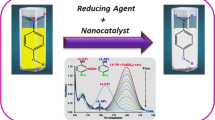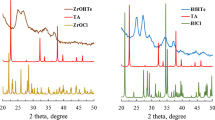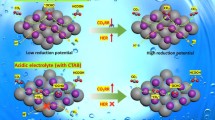Abstract
Oxidative transformation of 2-phenylethanol have been executed in pure aqueous and surfactant medium using Ce(IV) as the oxidant. A comprehensive kinetic analysis for the electron transfer process was made to predict the mechanism of transformation. The reaction progress was monitored by recording the decrease in absorbance of the oxidant Ce(IV) at the λmax (wave length of maximum absorbance) value of 315 nm. Pseudo first order conditions was maintained in the medium and acidity of the reaction environment was regulated by perchloric acid. The plot of log (absorbance) vs time for the disappearance of Ce(IV) was observed to be cleanly linear for up to three half-lives of the reaction and the nature of the plot was independent of initial concentration of Ce(IV) species indicating first order dependence of rate with respect to oxidant. The observation of rate variation in substrate (2-phenylethanol) concentration indicate Michaelis–Menten type of mechanism suggesting complex formation between the substrate and oxidant before the rate determining step. Inverse dependence of rate on acid strength has been observed. The kinetic and mechanistic study in surfactant medium was performed by introducing sodium dodecyl sulphate (SDS) to the reaction. In presence of the surfactant, the rate initially increased till the critical micelle concentration (cmc) is reached and then falls generating a hump in the [SDS] vs rate constant profile. The rate alteration and the interfacial micro-heterogeneous catalytic behavior of the environment friendly SDS in the pre- and post-cmc is explained by Berezin model. The effect of temperature on the reaction was monitored in the temperature range of 303–312 K. Positive activation enthalpy and free energy was recorded while the activation entropy was found to be negative. Based on all the experimental observations, suitable kinetic model has been proposed for the oxidation both in the pure aqueous and surfactant medium.
Graphical Abstract













Similar content being viewed by others
Data Availability
The authors confirm that the data supporting the findings of this study are available within the article itself.
References
Zueva OS, Rukhlov VS, Zuev YF (2022) Morphology of ionic micelles as studied by numerical solution of the Poisson equation. ACS Omega 7:6174–6183. https://doi.org/10.1021/acsomega.1c06665
Bari ML, Sonawane SH, Mishra S, Deshpande TD (2023) Surfactant assisted reactive crystallization of cobalt oxide nanoparticles in a tubular microreactor: effects of precursor concentrations and type of surfactants. React Chem Eng 8:355–364. https://doi.org/10.1039/d2re00350c
Mahbub S, Akter S, Luthfunnessa AP, Hoque MA, Rub MA, Kumar D, Alghamdi YG, Asiri AM, Cancar HD (2020) Effects of temperature and polyols on the ciprofloxacin hydrochloride-mediated micellization of sodium dodecyl sulphate. RSC Adv 10:14531–14541. https://doi.org/10.1039/d0ra00213e
Bhattarai A, Rub MA, Posa M, Saha B, Asiri AM, Kumar D (2022) Studies of ninhydrin and phenylalanine in cationic dimeric gemini micellar system: spectroscopic and conductometric measurements. Colloids Surf A Physicochem Eng Asp 655:130334. https://doi.org/10.1016/j.colsurfa.2022.130334
Sahu S, Padhy RK, Nanda SP (2023) Interfacial catalytic influence of sodium lauryl sulphate in the oxidation of cyclic alcohols by Cr(VI). Mater Today Proc. https://doi.org/10.1016/j.matpr.2023.05.644
Karmar P, Kundu S, Layek M, Karmar K, Mitra M, Mukherjee A, Dhak D, Mandal U, Sar P, Saha B (2023) An efficient mixed micellar strategy for the catalytic oxidation of benzyl alcohol by diperiodatoargentate(III) in aqueous media. New J Chem 47(28):13235–13246. https://doi.org/10.1039/D3NJ02023A
Padhy RK, Padhi AP, Patro R, Mahapatra B, Dash S, Sahu S (2023) Interfacial and surface adsorption phenomenon in the dissolution behavior of 8-hydroxy quinoline. Mater Today Proc. https://doi.org/10.1016/j.matpr.2023.08.374
Fatma N, Panda M (2020) A study on the solubilization of polycyclic aromatic hydrocarbons in gemini-conventional mixed surfactant systems by 1H NMR spectroscopy. Mater Chem Phys 254:123223
Rosen MJ, Kunjappu TJ (2012) Surfactants and interfacial phenomena. Wiley, New Jersey
Bhattamishra SD, Padhy RK (2009) Estimation of Ibuprofen solubilization in cationic and anionic surfactant media: application of micelle binding model. Ind J Chem Tech 16:426–430
Chowdhury B, Ghosh A, Rahaman SKM, Saha B (2023) Cooperative rate amplification by binary surfactant (CPC/TX-100) nano-aggregates on the diperiodatocuprate(III) (DPC) oxidation of 2-butanol in aqueous medium. Res Chem Intermed 49:4041–4063. https://doi.org/10.1007/s11164-023-05069-5
Sen PK, Midya JK, Bysakh S, Pal B (2017) Kinetic and mechanistic studies on the oxidation of d-glucose by MnO2 nanoparticles. Effect of microheterogeneous environments of CTAB, Triton X-100 and Tween 20. Mol Catal 440:75–86. https://doi.org/10.1016/j.mcat.2017.07.009
Kundu S, Karmar P, Rahaman SKM, Mitra M, Rajwar S, Dhibar S, Layek M, Sar P, Saha B (2023) A promising mixed micellar approach to tune the oxidation of isoprenol by diperiodatoargentate(III) in aqueous media. New J Chem 47:4364–4373. https://doi.org/10.1039/d2nj05120f
Thiruvengetam P, Chakravarthy RD, Chand DK (2019) A molybdenum based metallomicellar catalyst for controlled and chemoselective oxidation of activated alcohols in aqueous medium. J Catal 376:123–133. https://doi.org/10.1016/j.jcat.2019.06.013
Chowdhury B, Rahaman SKM, Ghosh A, Mahali K, Sar P, Saha B (2022) Synergistic reinforcement of CPC/TX-100 mixed micellar microenvironment for diperiodatocuprate(III) (DPC) oxidation of 1-propanol and 1,3-propanediol. Coord Chem Rev 368:120817. https://doi.org/10.1016/j.molliq.2022.120817
Sar P, Saha B (2020) Potential application of Micellar nanoreactor for electron transfer reactions mediated by a variety of oxidants: a review. Adv Colloid Interface Sci 284:102241. https://doi.org/10.1016/j.cis.2020.102241
Acharjee A, Rakshit A, Chowdhury S, Datta I, Barman MK, Ali MA, Saha B (2019) Micellar catalysed oxidation of hydrophobic fatty alcohol in aqueous medium. J Mol Liq 293:111475. https://doi.org/10.1016/j.molliq.2019.111475
Khan MN (2007) Micellar catalysis, surfactant science series, 133,. CRC Press, Taylor & Francic Group, Boca Raton
Shi Y, Shen M, Wang Z, Liu C, Bi J, Wu L (2023) Visible-light-driven benzyl alcohol oxidation over Pt/Mn-Bi4Ti3O12 nanosheets: structure–function relationship of multicomponent photocatalysts. J Catal 418:141–150. https://doi.org/10.1016/j.jcat.2023.01.015
Liu X, Xia Q, Zhang Y, Chen C, Chen W (2013) Cu-NHC-TEMPO catalyzed aerobic oxidation of primary alcohols to aldehydes. J Org Chem 78:8531–8536. https://doi.org/10.1021/jo401252d
Wang D, Wang P, Wang S, Chen YH, Zhang H, Lei A (2019) Direct electrochemical oxidation of alcohols with hydrogen evolution in continuous-flow reactor. Nat Commun 10:2796. https://doi.org/10.1038/s41467-019-10928-0
Guomundsson A, Schlipkoter KE, Backvall JE (2020) Iron(II)-catalyzed biomimetic aerobic oxidation of alcohols. Angew Chem Int Ed 59(13):5403–5406. https://doi.org/10.1002/anie.202000054
Ma P, Zhang P, Shu J, Yang B, Zhang H (2018) Characterization of secondary organic aerosol from photo-oxidation of gasoline exhaust and specific sources of major components. Environ Pollut 232:65–72. https://doi.org/10.1016/j.envpol.2017.09.018
Lyulyukin MN, Besov AS, Vorontsov AV (2013) Oxidation of ethanol vapors in negative atmospheric corona discharge. Ind Eng Chem Res 52:5842–5848. https://doi.org/10.1021/ie400476p
Marinov NM (1999) A detailed chemical kinetic model for high temperature ethanol oxidation. Int J Chem Kinet 31:183–220. https://doi.org/10.1002/(SICI)1097-4601(1999)31:3%3c183::AID-KIN3%3e3.0.CO;2-X
Li M, Lang X, Cabera MM, Keyser SD, Sun X, Silva ND, Wheeldon I (2021) CRISPR-mediated multigene integration enables Shikimate pathway refactoring for enhanced 2-phenylethanol biosynthesis in Kluyveromyces marxianus. Biotechnol Biofuels 14:3. https://doi.org/10.1186/s13068-020-01852-3
Otten A, Wooten M, Medrano A, Fathi Y, Meloni G (2018) Investigation of oxidation reaction products of 2-phenylethanol using synchrotron photoionization. J Phys Chem A 122(33):6789–6798. https://doi.org/10.1021/acs.jpca.8b03985
Chimatadar SA, Madawale SV, Nandibewoor ST (2007) Mechanistic study of iodide catalysed oxidation of l-glutamic acid by cerium(IV) in aqueous sulphuric acid medium. Trans Met Chem 32(5):634–641. https://doi.org/10.1007/s11243-007-0222-6
Tandon PK, Sahgal S, Gayatri PM, Dhusia M (2006) Oxidation of ketones by cerium(IV) in presence of iridium(III) chloride. J Mol Catal A Chem 250:203–209. https://doi.org/10.1016/j.molcata.2005.12.045
Satapathy PK, Baral DK, Aswar AS, Mohanty PP (2013) Kinetics and mechanism of vanillin by Cerium(IV) in aqueous perchlorate medium. Ind J Chem Tech 20(4):271–275
Wisniewska J, Wrzeszcz G, Kurzawa M, Eldik RV (2012) The oxidative degradation of dibenzoazepine derivatives by cerium(iv) complexes in acidic sulfate media. Dalton Trans 41:1259–1267. https://doi.org/10.1039/C1DT11664A
Naik DV, Byadagi KS, Nandibewoor ST, Chimatadar SA (2013) Kinetics and mechanistic study of manganese(II)-catalyzed cerium(IV) oxidation of thiamine hydrochloride in aqueous perchloric acid medium by stopped flow technique. Monatsh Chem 144:1307–1317. https://doi.org/10.1007/s00706-013-1005-8
Xu L, Tian H, Yao H, Shi T (2018) New kinetic and mechanistic findings in the oxidation of hydroxylamine by Cerium(IV) in perchloric acid media. Int J Chem Kinet 50:856–862. https://doi.org/10.1002/kin.21220
Padhy RK, Bhattamisra SD (2021) Surfactant catalyzed oxidation of ethanolamines by Ce(IV). Asian J Chem 33(1):21–25. https://doi.org/10.14233/ajchem.2021.22907
Padhy RK, Sahu S (2021) Zirconia supported rhodium nano materials: catalytic application in selective oxidation of alcohols. Mater Today Proc 47:2276–2280. https://doi.org/10.1016/j.matpr.2021.04.204
Padhy RK, Sahu S (2023) Oxidation of Iminodiethanol by Ce (IV) in microheterogeneous system: a comprehensive kinetic analysis. J Dispers Sci Technol 44(9):1584–1594. https://doi.org/10.1080/01932691.2022.2026783
Sahu S, Padhy RK, Nanda SP (2023) Surfactant catalyzed electron transfer mechanism in the oxidation of racemic tartaric acid by Ce(IV). Mater Today Proc 78:786–791. https://doi.org/10.1016/j.matpr.2022.10.276
Jeffry JH, Basset J, Mendham J, Denny RC (1996) Vogel’s text book of quantitative chemical analysis, 5th edn. ELBS, Longman, Essex
Vogel AI (1973) A text book of practical organic chemistry including qualitative organic analysis. ELBS, Longman, Essex
Pondit AK, Das A, Banerjea D (1991) Kinetics and mechanism of oxidation of 8-hydroxyquinoline and its derivatives by cerium(IV) through precursor complex formation. Trans Met Chem 16:324–327. https://doi.org/10.1007/BF01024074
Padhy RK, Sahu S (2021) Kinetic investigation of oxidation of alkanolamine by Cerium (IV) in acidic medium: catalytic effect of Mn(II). J Chem Sci 133(3):1–11. https://doi.org/10.1007/s12039-021-01921-6
Waters WA, Wilson IR (1966) Mechanism of the oxidation of hydroxylamine by ceric sulphate. J Chem Soc A. https://doi.org/10.1039/J19660000534
Doherty AMM, Radcliffe MD, Stedman G (1999) Kinetics of oxidation of nitrogen compounds by cerium(IV). J Chem Soc Dalton Trans 18:3311–3316. https://doi.org/10.1039/A904080C
Padhy RK, Sahu S (2022) Oxidation of triethanolamine by ceric ammonium sulphate in aqueous sulphuric acid: spectrophotometric kinetic and mechanistic study. Monatsh Chem 153(1):69–78. https://doi.org/10.1007/s00706-021-02874-9
Onel L, Buurma NJ (2011) The nature of the sodium dodecylsulfate micellar pseudophase as studied by reaction kinetics. J Phys Chem B 115(45):13191–13211. https://doi.org/10.1021/jp208171w
Blasko A, Bunton CA, Foroudian HJ (1994) Reactivities of thiol and thione phosphorus(V) esters in nonmicellized amphiphiles. J Colloid Interface Sci 163:500–506. https://doi.org/10.1006/jcis.1994.1129
Fendler EJ, Fendler JH (1975) Catalysis in micellar and macromolecular systems. Academic Press, New York
Berezin IV, Martineck K, Yatsimirskii AK (1973) Physicochemical foundations of micellar catalysis. Russ Chem Rev 42:787–802. https://doi.org/10.1070/RC1973v042n10ABEH002744
Funding
Not applicable.
Author information
Authors and Affiliations
Corresponding author
Ethics declarations
Conflict of interest
The authors declare that they have no conflict of interest.
Informed consent
Not applicable.
Ethical approval
Not applicable.
Rights and permissions
Springer Nature or its licensor (e.g. a society or other partner) holds exclusive rights to this article under a publishing agreement with the author(s) or other rightsholder(s); author self-archiving of the accepted manuscript version of this article is solely governed by the terms of such publishing agreement and applicable law.
About this article
Cite this article
Sahu, S., Nanda, S.P. & Padhy, R.K. Interfacial Micro-heterogeneous Surface Phenomenon in the Oxidative Transformation of 2-Phenylethanol by Ce(IV). Chemistry Africa 7, 1605–1617 (2024). https://doi.org/10.1007/s42250-023-00809-x
Received:
Accepted:
Published:
Issue Date:
DOI: https://doi.org/10.1007/s42250-023-00809-x




